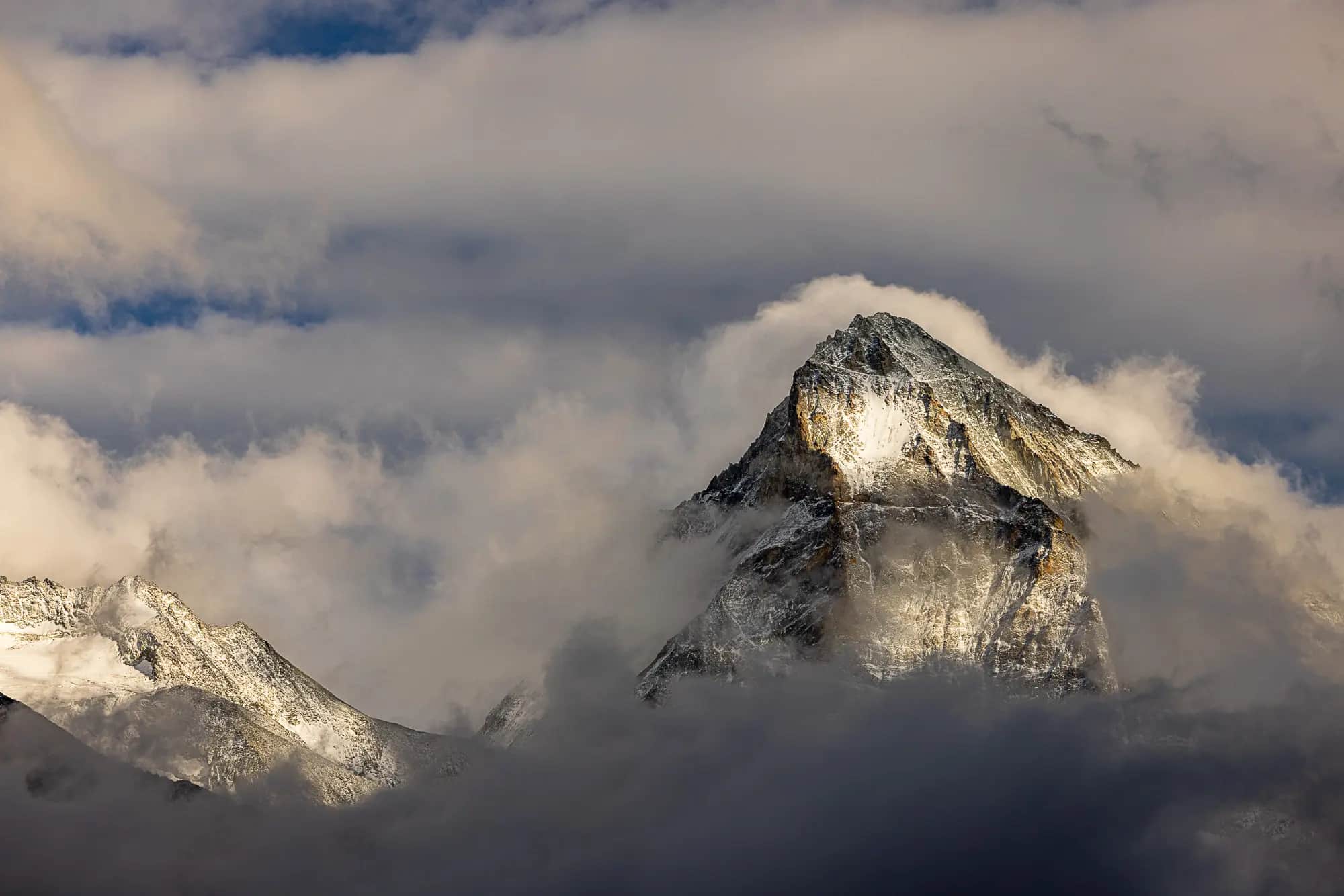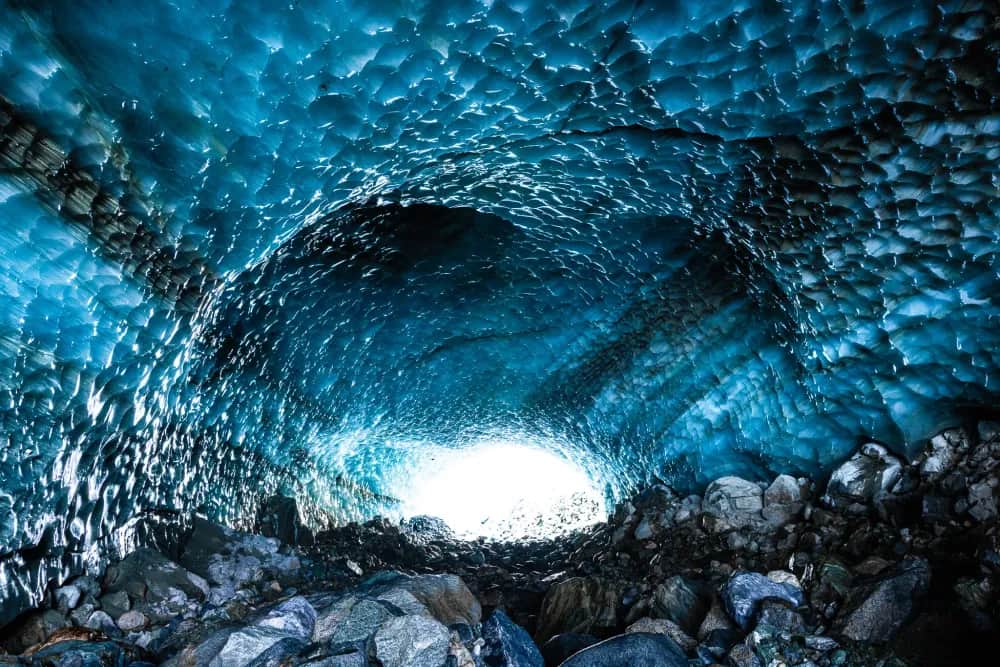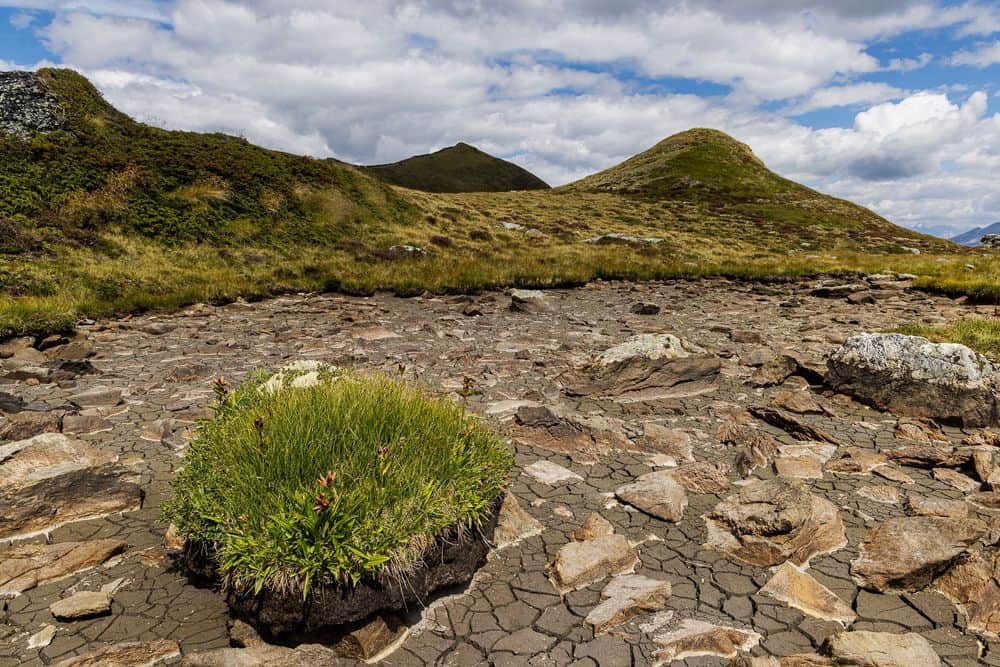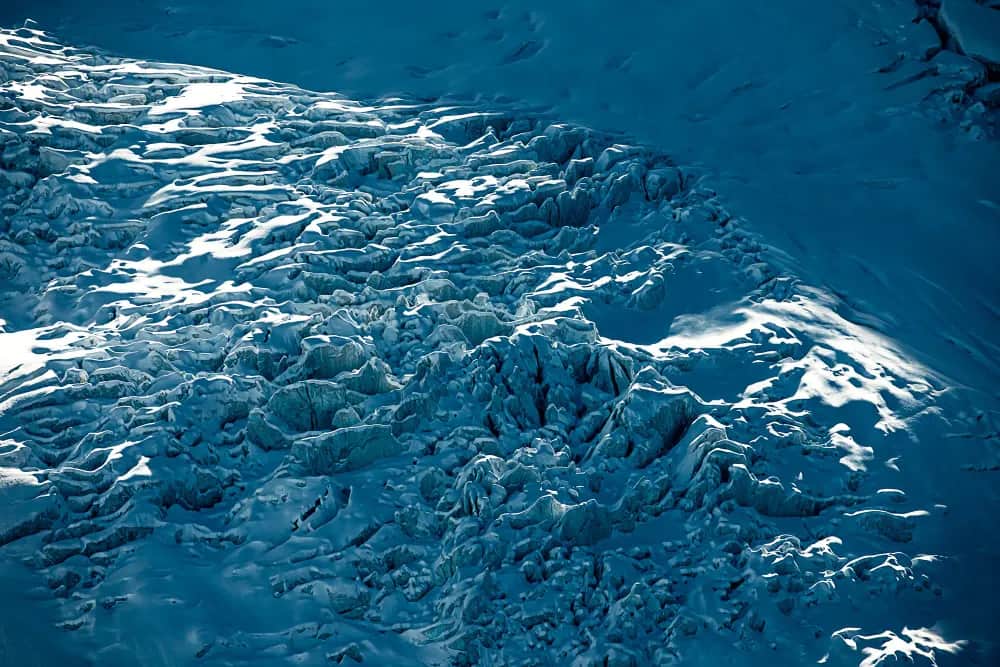„Germany has only four glaciers left after hot summer“. „ Alpine glaciers melting at record pace”“. „ Swiss glaciers lose 6% of their total mass in one year..“ The list of media releases, reams of studies and research results gets longer, longer and longer. Year after year, new superlatives are added, summer after summer, something happens that, next to the big problem child CO2, is rather less in the focus of public perception: the irreversible melting of glaciers due to climate change.
The summer of 2022, a sad record year for the glacier ice
It is the beginning of July 2022, a hot summer’s day in the Swiss Alps, more precisely in the second hottest summer since 1984. In June of this year, it was already well over 30 degrees in many places, the zero degree limit is often above 4000 meters, sometimes even at 4500 meters. Switzerland’s highest mountain, the Dufourspitze, only manages a good 100 meters more in altitude.
The summer of 2022 will go down in history as the worst summer ever for the glaciers in the Alps. Whether in the Engadine, in the Bernese Oberland, in the Valais, in the glaciated regions of Austria, Italy or around the puny remnants of Germany’s now only four “glaciers”: everywhere the ice melt has reached speeds and dimensions that have surprised even experienced researchers. The average thickness of ice loss on Swiss glaciers in 2022 alone is three meters, and some glaciers in Valais or Engadin have lost up to six meters of thickness in one summer.
In this article we would like to create a space for the glaciers of the Alps, through facts but also with pictures, to leave the impression they deserve. Our journey takes us from the Morteratsch glacier in the Engadine to the Glacier de Cheilon in the Valais to a now collapsed glacier cave near Arolla. But also the glaciers of Northern Europe will get their space, until we will finally deal with the big questions around glaciers in climate change.
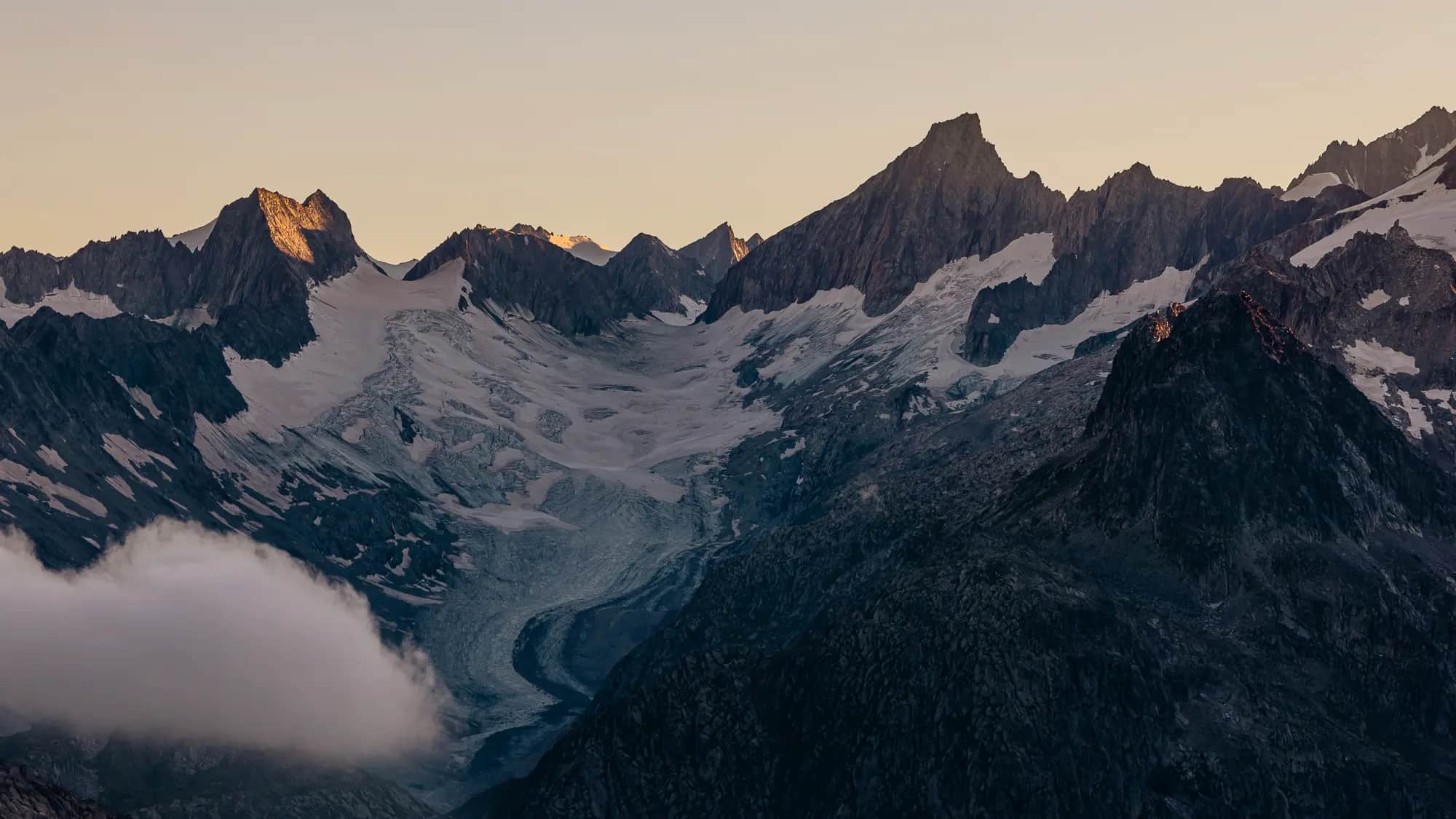
Morteratsch Glacier, Engadine
Autumn 2021, Val Morteratsch in the Engadine. I am 36 years old at the time of the visit for this article, have spent many years of my life on alpine tours in the Alps. Already as a child, I was able to visit the Engadine with my parents on summer vacation, proudly made my first “real” high altitude tour there to the 3751 m high Piz Morteratsch. In one day, completely from the valley from Camping Morteratsch, in the evening back again. About 2000 meters of altitude, a jagged climb for an adolescent.
Further visits to the Engadine followed, many tours around and up the famous Piz Bernina (4049 m), in winter as well as in summer. Always prominently in view: the impressive Vadret da Morteratsch, the Morteratsch glacier, which begins after a 45-minute walk from the Rhaetian Railway station of the same name, nestled in autumn in the larch-lined mountain slopes of the Engadine.
The glacier at that time: a giant, gently sloping at the beginning, an enormous glacier tongue of ice, ideally sloped to make the first walking attempts with crampons. In about an hour one reached approximately the height of the Boval hut, an SAC hut on the western edge of the Morteratsch glacier at 2494 meters. From the east, the Vadret Pers, coming from Piz Palü, breaks off towards the Morteratsch glacier with an impressive glacier break full of seracs and crevasse zones; further into the valley, the notorious Buuch, a maze of crevasses below Piz Bernina, awaits the winter alpinists.
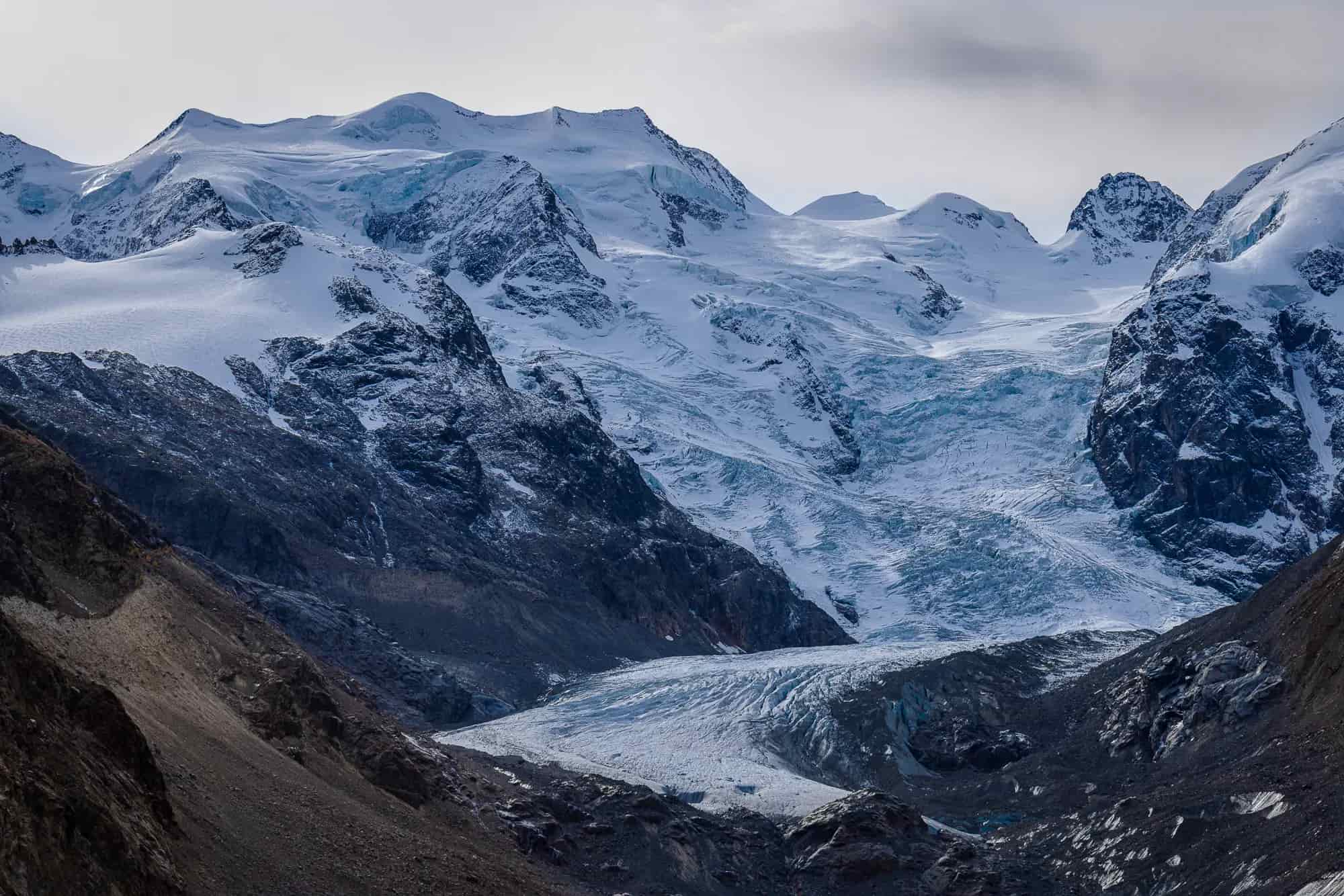
Time jump, more than 20 years later. Autumn 2021 is a normal autumn, although what is normal in these times? The summer before that was not a striking summer of heat, but nevertheless temperatures have been consistently and permanently much too warm for many years. The Vadret Morteratsch presents itself in a sad state. This proud ice stream has lost over a kilometer in length and many meters in thickness in this period between 2001 and 2021. The ice tongue has given way to a scree slope, there is no longer any question of a gentle slope; in fact, it can no longer even be seen from the valley. Many new panels have been added to the glacier nature trail, all of them testifying to the enormous speed with which the glacier has retreated over the past two decades – and there is no end in sight.
Around 2014/2015, the glacier melted to such an extent that a huge rock bar was revealed, a death sentence for the surrounding ice: the rock warming in the sun only accelerated the melting. The result a few years later: a rock step about 80 m high, covered with sandy debris, the glacier having retreated into the basin behind it.
The revealing and extensive map material of Switzerland from Swisstopo impressively shows the retreat between 2001 and 2021:
Vadret da Morteratsch 2001
In 2001, nothing can be seen of the massive rock step that is visible today; the glacier tongue is a gently sloping tongue of ice that can be entered without difficulty at the end of the glacier trail.
Vadret da Morteratsch 2021
In 2021, the glacier tongue has lost about 500 m in length compared to 2001 and has retreated over the prominent rock outcrop. The river delta of the meltwater has become significantly larger.
The Morteratsch glacier has been measured and researched for about 150 years. With the help of the collected data and taking into account the most current data for the Swiss climate scenarios in 2022 (CH2018), a glacier model was developed by the University of Fribourg, which impressively visualizes the development of the glacier under the assumption of no to strong climate protection.
The sobering realization is that (regardless of the measures taken to protect the climate) the decline of the Vadret da Morteratsch to a fraction of its current extent cannot be stopped even with the most rigorous climate protection. Today’s sight, which is probably familiar to every visitor to the Engadine and the impressive view of the arena of the Bernina massif covered with white-blue glaciers: from the middle of this century (i.e. already in about 20-30 years), this sight will no longer exist in this way; in 40 years, only the highest peaks will still bear a white cap.
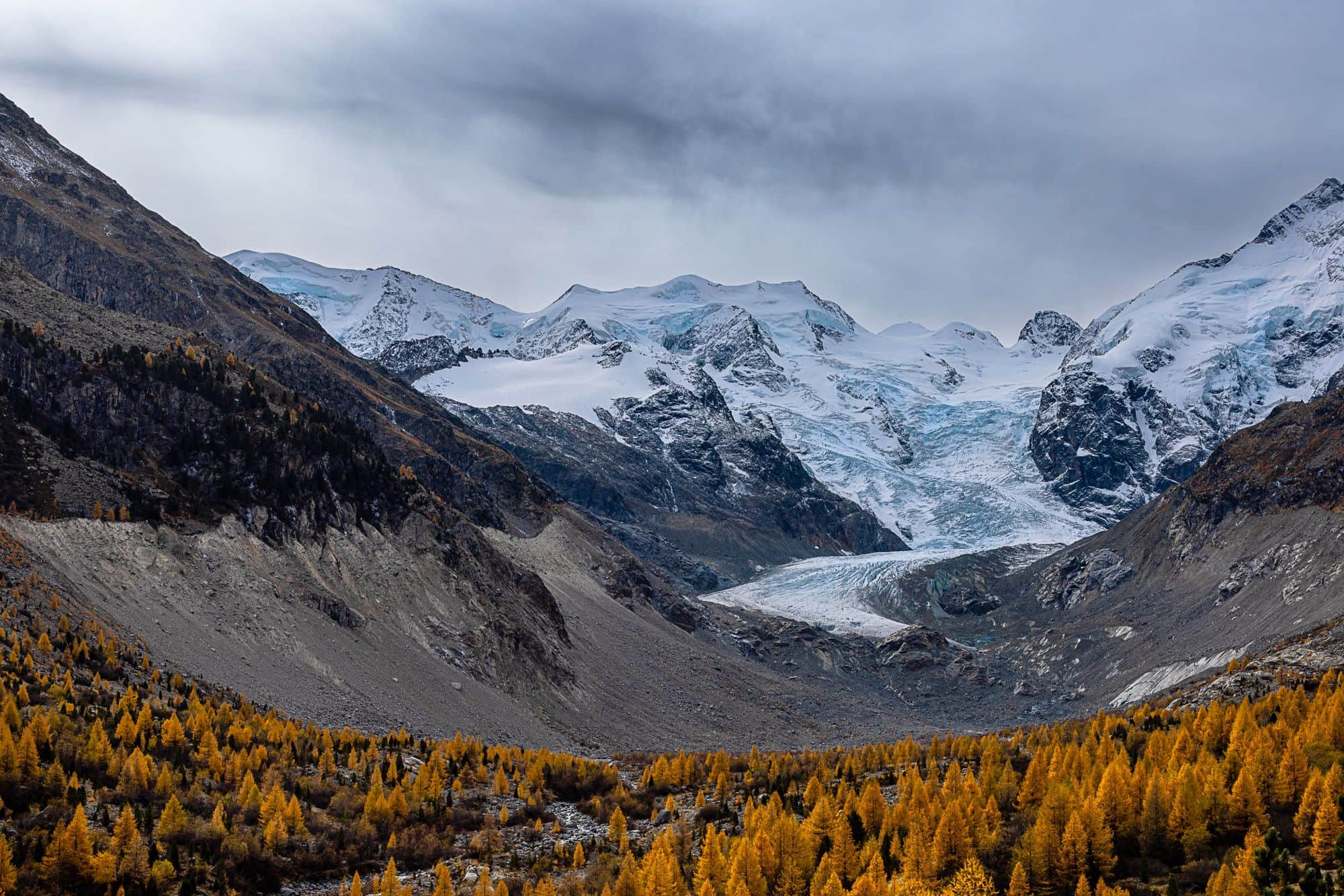
Glacier de Cheilon, Lower Valais
Change of location to the west of Switzerland, to the Val d’Hérens in the Valais. From the picturesque mountain village of Arolla, my path today in July 2022 leads me up to the Pas de Chèvres, a 2854 meter high crossing and one of the approaches to the Cabane des Dix. The SAC mountain hut is the starting point for various high altitude tours and is heavily frequented in summer and winter as part of the Haute Route.
The ascent is a leisurely hike without technical difficulties, but with a strong view over the large basin below the striking Mont Blanc de Cheilon. The traverse of Pigne d’Arolla and Mont Blanc de Cheilon is a moderately difficult high altitude tour, conditions permitting. If there is blank ice, the ridge traverse becomes serious, looking around here today, that seems to be exactly the case.
We remember: it’s early July, so summer in the high Alps has just begun.
Arrived at the pass, my good mood from the ascent has abruptly disappeared. The view down the steep west side of the pass to the Glacier de Cheilon: depressing. Instead of masses of ice, I see masses of rubble, I have to really look for the white spots with snow or ice. Apere rocks and debris slopes up to well over 3000 meters, the glacier stream a pure stream of debris and rock.
Directly below me: a huge glacial lake, which I am sure was not there during one of my last visits here in 2012. Another look at the historical maps of Swisstopo shows that my guess is correct. How much ice must melt to form a glacial lake over 500 m long? How will this water affect the further course of the glacier melt, since the formation of glacial lakes is known to accelerate melting, and if the glacier tongue ends in a lake, the flow velocity doubles on average?
Glacier de Cheilon 2014
Glacier de Cheilon in 2014, still without glacial lake. The glacier tongue is still a continuous mass of ice.
Glacier des Cheilon 2021
The Glacier de Cheilon in 2021, just seven years later, with a glacier lake about 500 meters long around the glacier tongue.
One of the goals of my landscape photography is to show the irreversible transience of glaciers in all their depressing yet majestic power. In images like the following, this approach regularly reaches its limits, as the sheer size and expanse (in this case of the glacier lake) far exceeds any normal image sizes. The proportions are elusive – if you look closely, you will see four alpinists moving towards Cabane des Dix just below the tongue of ice flowing into the lake.
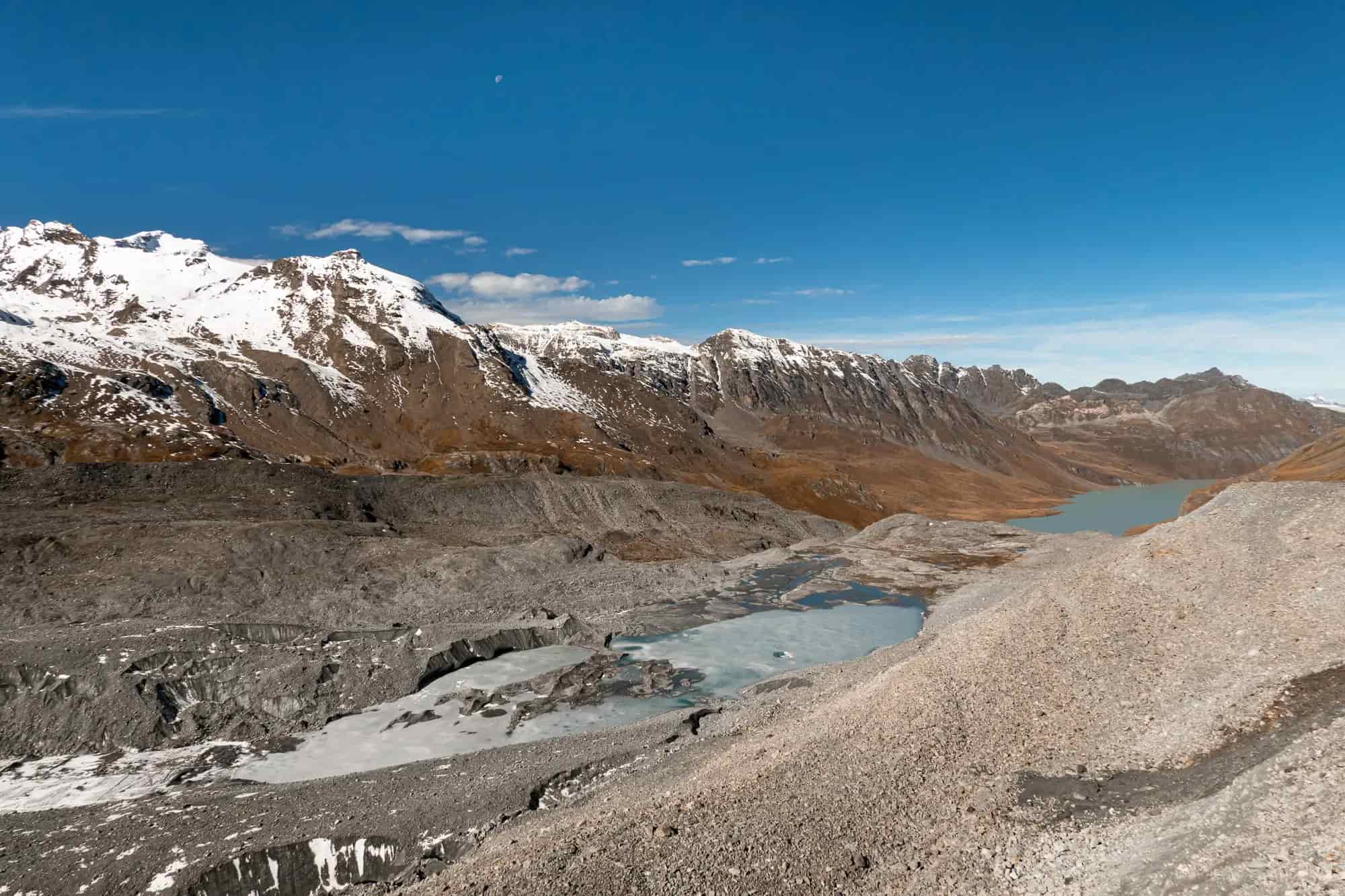
It is a depressing sight that presents itself to me here. As with many other glaciers in the Alps (and even in the far north of Norway), the demonstrable man-made destruction of this unique landscape by climate change is showing itself in full force. Knowing that this unique glacier world will probably never return (and especially not in my lifetime) makes me, as so often, thoughtful, sad and angry.
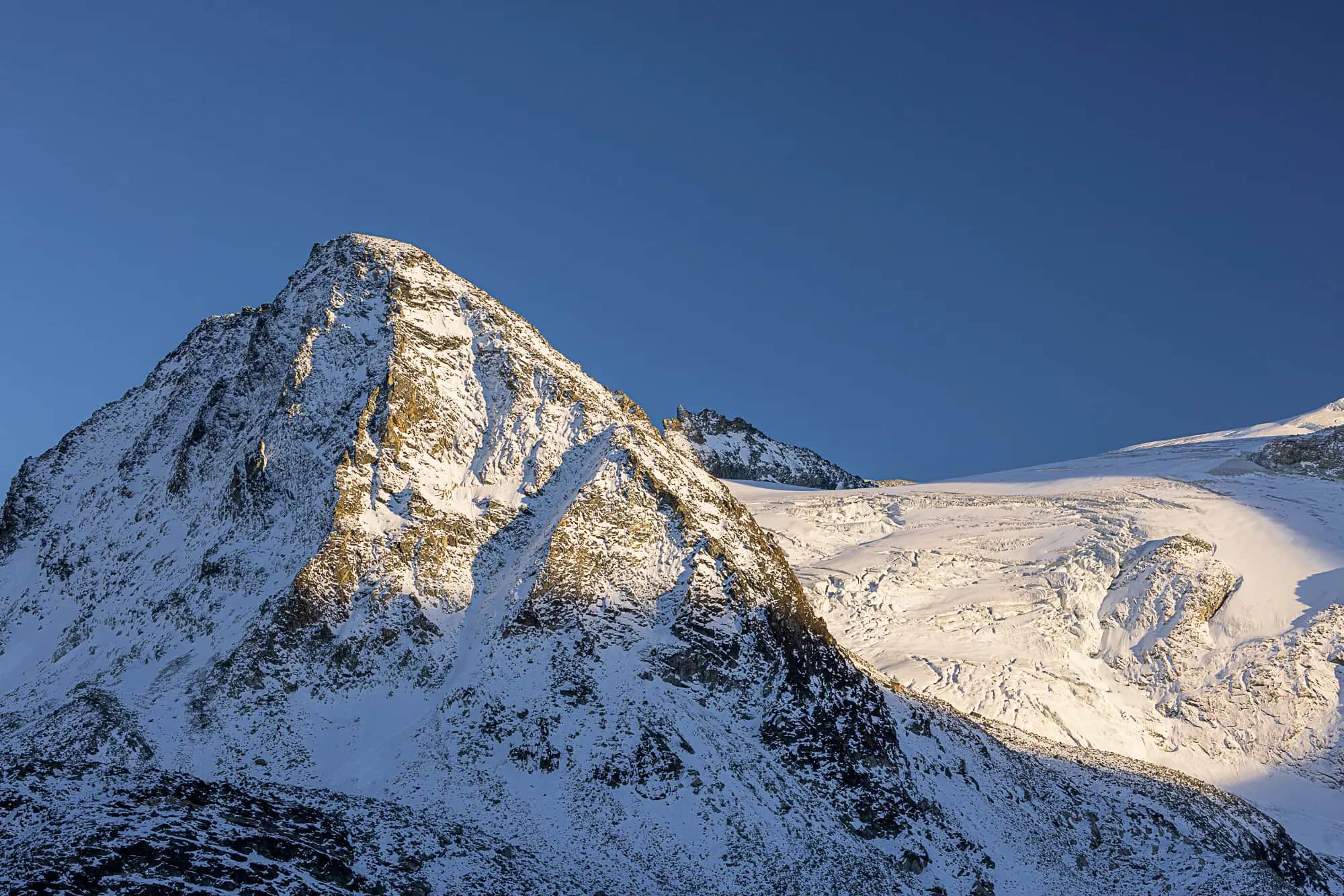
Bas Glacier d’Arolla, Lower Valais
Marina and I are on the approach over the glacier forefield, which only consists of scree, up to an ice cave that has recently formed in the Bas Glacier d’Arolla. At an altitude of 2300 meters, the huge entrance is visible from afar, the ice shimmering from deep blue to white-gray depending on the light. All around, however: only boulders. No ice far and wide, only a few hundred meters higher up, the Glacier du Mont Collon hangs over the rock edge.
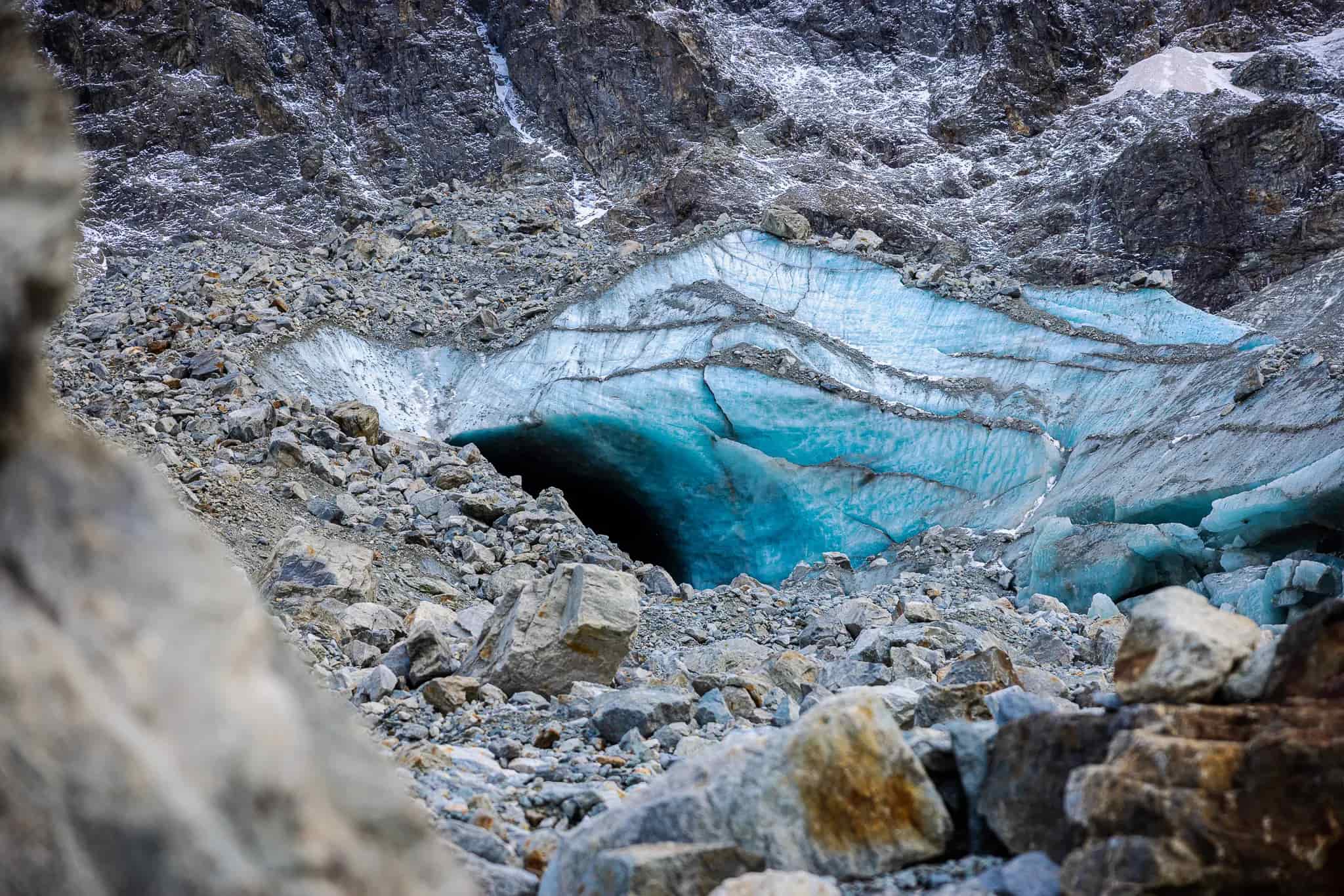
Ice caves are fragile structures, their entry is not safe and should be avoided, especially during the summer months. The temperatures today are cold, they have been for several days, it is late autumn and the approaching winter has already left its mark. Obviously not everyone attaches the necessary importance to self-protection, besides us there are a few other people here, many of them not even wearing helmets.
The dimensions of the glacier cave are enormous, it is estimated to be about 100 meters long and at the highest point in the middle of the ice tunnel certainly about 10 meters high. The mass of ice that has been carved out here is hard to grasp – it is almost impossible to believe that all this was created solely by the force of water.
Inside the ice we can admire the incredible structures of the ice cave, deep blue shimmers the ice, while at the bottom the meltwater of the glacial stream ripples along in a thin trickle. Today, the small stream is hardly visible, but given the dimensions of the ice cave, one can imagine what it looks like here in spring during the snowmelt, because it is also this stream that has significantly shaped the ice cave.
The eternal ice, turned into water and rushed into the valley, from where it will not find its way back to feed the glacier from its nutrient zone as new snow and later ice.
Thoughtfully we are on our way back, through yellow larch forests we are heading again to Arolla, the starting point of our little excursion into the interior of a glacier. Here, too, a subsequent research reveals the clearly visible retreat of the glacier. A few dozen years may be a long period of time for us humans, but if we consider the life span of a glacier, where we are talking about many thousands of years, the speed of the retreat that is now beginning is only one thing: frightening.
Incidentally, on the night of September 19-20, 2022, what inevitably had to happen happened to this ice cave: the glacier cave, already doomed by the high temperatures, collapsed at 1:48 a.m. that night when a weak earthquake struck the Mont Collon region. A natural construction, even a work of art, which a few people had the privilege of discovering, is now history forever. More tons of ice will now melt rapidly and flow as rushing water through the Val d’Hérens down into the Rhone.
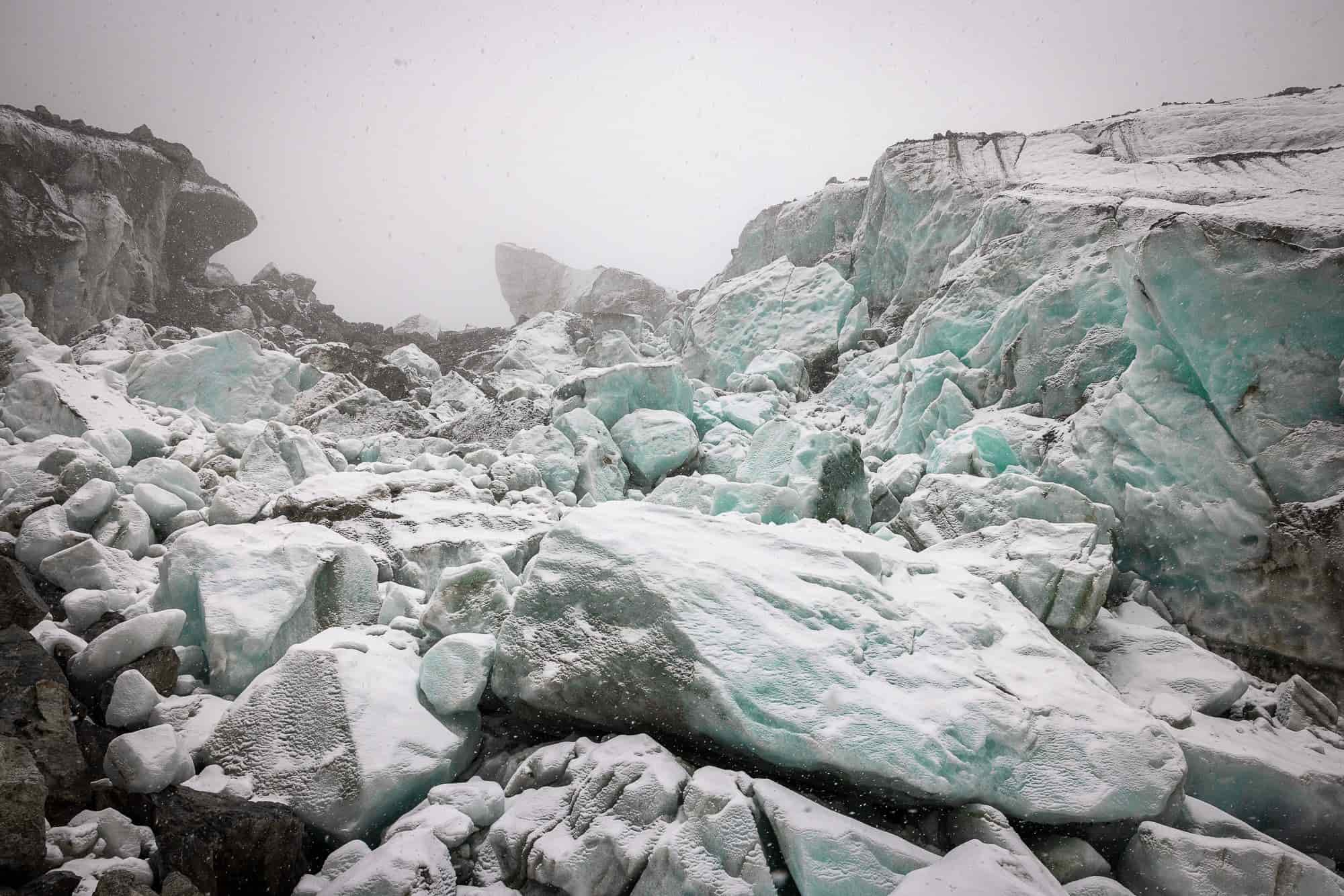
There are many observations like this. Be it events like in the German Ahr Valley in the summer of 2021 or the situation in Pakistan in 2022, which cost millions of people their homes. The events like these, which are increasing in frequency, should wake us up, especially when combined with the many other situations in Europe and the rest of the world where global warming has already been visible and noticeable to each of us for many years.
But does it?
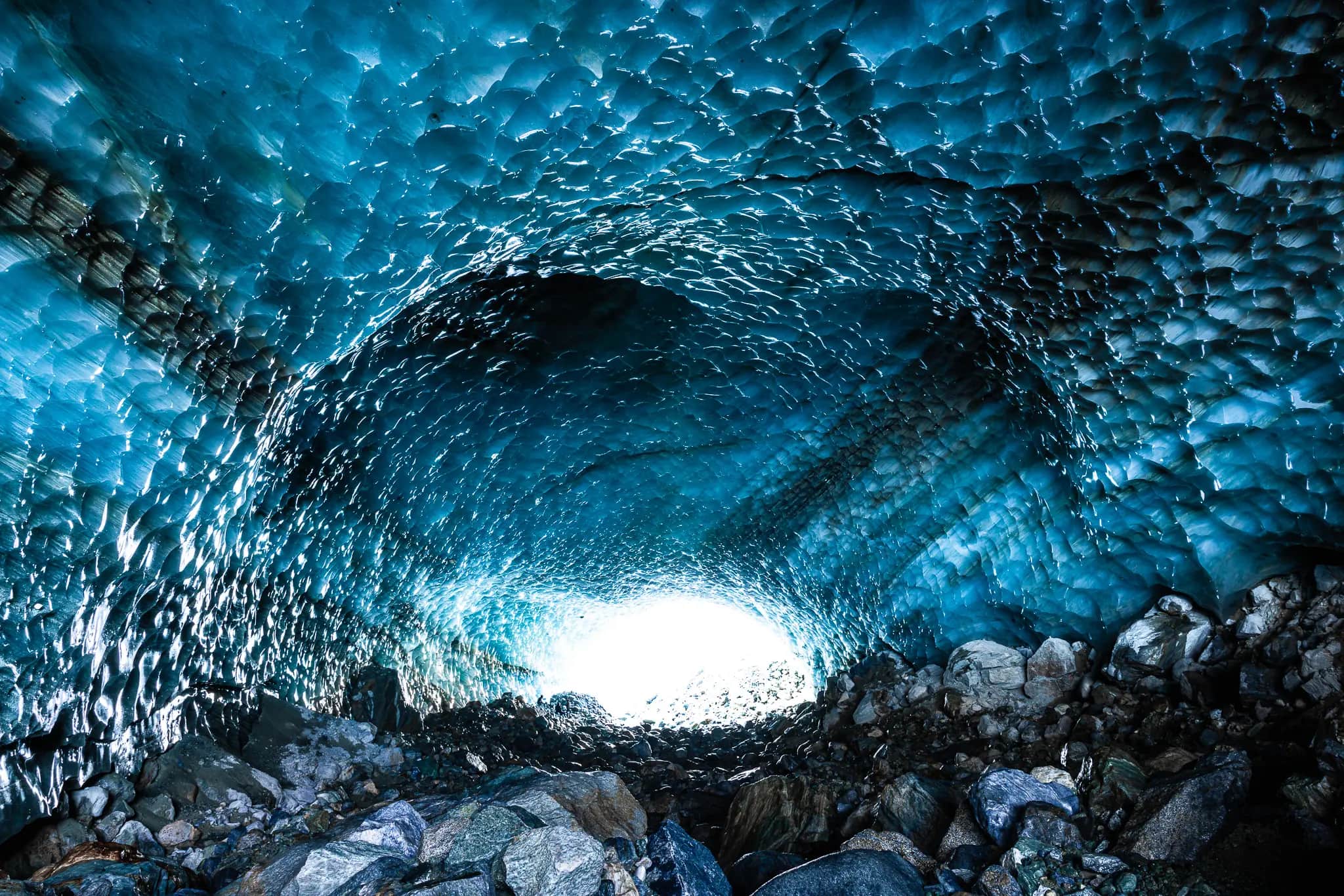
Glaciers in climate change in Northern Europe
The fact that the glaciers in Central Europe and thus in the Alpine region have been losing mass and length for decades and that this trend is continuing unabated is comparatively easy for the population to witness. Particularly in summer tourism, but also in winter for skiers and alpinists, the shrinking landmarks of the Alps catch the eye, and this topic is also receiving increased media attention. Some of the better known glaciers, such as the Morteratsch glacier or the Rhone glacier near the Furka Pass (Swiss landscape photographer Tobias Ryser accompanied the ETH Water Research Institute as a photographer and captured the work of the researchers at the glacier lake in impressive pictures) now make it into the media relatively often, unfortunately mostly with negative headlines about recent records of retreat.
However, the melting of glaciers due to global warming does not stop at the partly huge glaciers in Northern Europe. Even Europe’s largest inland glacier, the monumental Jostedalsbreen, will have completely disappeared by 2100, with a significant impact on drinking water reserves. If you consider that the ice of the Jostedalsbreen is between 50 and in places up to 600 meters thick, you can imagine the sheer inconceivable amount of frozen water that will accumulate in a total area of over 450 square meters.

The impact, however, is of course far from being felt only locally, but in combination with all the melting glaciers around the world, it creates consequences that affect everyone, not just the respective tourist destinations.
Why glacier melt affects us all
Is glacier shrinkage more of a luxury problem for tourists, skiers and alpinists? Or does it have other effects that also affect other parts of the population? If you ask yourself this question, at first glance it seems to be a rather cosmetic problem. The ice masses are too far away for most people, and there is too little understanding for this sensitive ecosystem in large parts of the population. However, this view quickly changes when we think about the sources from which we obtain part of our renewable energy, why the Alps are called the water castle of Europe and why even well-known alpine tours such as on the Matterhorn or Mont Blanc can already partly no longer be carried out in the summer months.
Electricity from hydropower
Looking at the large reservoirs such as Lac de Dix in the canton of Valais or around the Grimsel Pass in the Bernese Oberland in Switzerland, inevitable questions about the origin of all that water quickly arise. Will it still be possible in the future to meet the increased demand for electricity with these monumental structures, built solely for energy production? The inevitable energy turnaround is yet to come, but already many (reservoir) lakes are suffering from the increasingly dry summers and are repeatedly only partially filled. If then the inflow from the glaciers (which is to be regarded as decisive) disappears, what will happen then?

Drinking water reserves in the soils
It is at least theoretically conceivable to replace energy production from declining hydropower with other renewable energy systems, such as solar energy or wind power. What we cannot compensate for, however, is the supply of drinking water. For this vital elixir, some 1.6 billion people worldwide rely on the existence of glaciers. For this part of humanity, drinking water comes more or less directly as melting water from the glaciers in the mountains. A lack of water would undoubtedly lead to social, political and ecological tensions in the affected regions.
In addition, there are entirely new problems, which at first glance seem rather far-fetched, such as the release of dangerous germs from the melting ice. In view of the unstoppable glacier melt, the question inevitably arises as to whether the course has already been set for this gloomy future scenario.
Switzerland is considered the water castle of Europe, which it owes to the enormous natural occurrence of water reserves in the glaciers, lakes and rivers. However, as one of the most water-rich countries in Europe, it will also have to adjust to water shortages in the future, at least locally and for a limited period of time – a drastic and unthinkable development for many people, considering that they take the availability of drinking water for granted.
How will a population that has become accustomed to a life of abundance (in terms of the availability of vital resources) over decades react to such shortages?
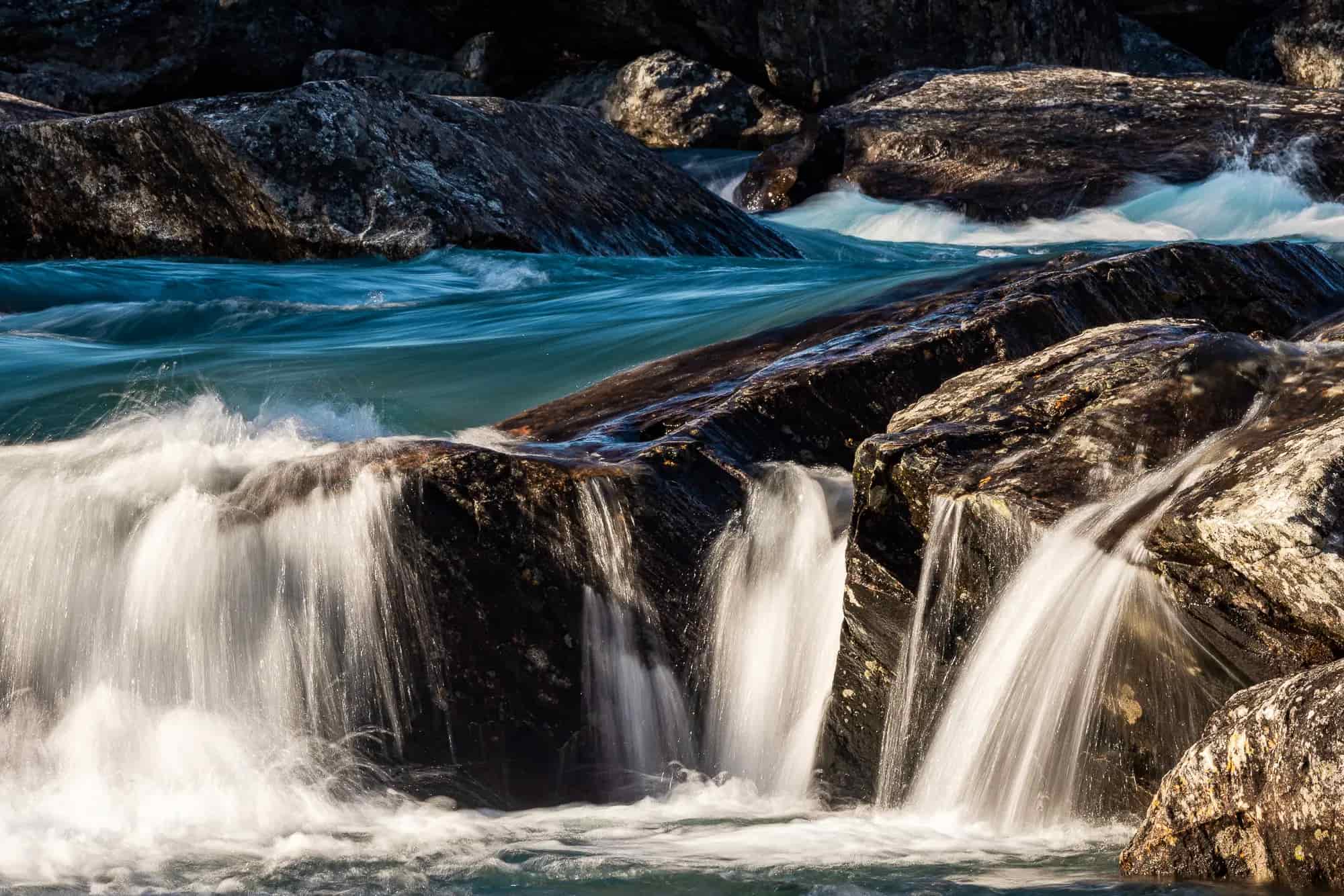
Thawing permafrost and natural disasters
If the average annual temperature in a certain region is at most -1° Celsius, permafrost forms in the ground there. All the material in the ground, be it sand, stone, gravel or earth, is stuck together, as it were, by the ice formed and forms a stable mass up to several hundred meters thick. This stability benefits the regions where permafrost forms, which in the Alpine regions are altitudes above around 2100 meters, depending on the exposure.
Now, in the mountains, many of these permafrost soils are not so much soils as slopes. The consequences of a thawing of the permafrost on these structures had to be experienced, for example, by the people of Gondo in Bergell on August 23, 2017, when a famous alpine route at the 3369-meter-high Piz Cengalo, together with several million cubic meters of granite, went down into the depths. The permafrost that had held these millennia-old rock structures together had thawed.
Now the thawing permafrost has first of all no direct relation to the melting of the glaciers (except it now additionally methane is released, which additionally strongly boosts the warming of the earth’s atmosphere). Both processes are caused by the too high average temperatures, but lead to similar potential catastrophes in the regions below the glacier. Due to permafrost, mountain slopes lose their stability and can rush into the valley in debris flows, rock avalanches or landslides. There, rivers dammed by the masses of material can overflow their basins and cause flooding in inhabited areas downstream.
A similar situation occurs in part due to the glacial lakes that form as a result of glacial melt: the large quantities of water cannot be contained at all by the terrain structures in some cases, which can lead to the breaking of terrain basins with subsequent flood waves – again with the corresponding consequences for the inhabited regions below. The glacial lake on the Plaine Morte glacier plateau in the Lower Valais is one such example.
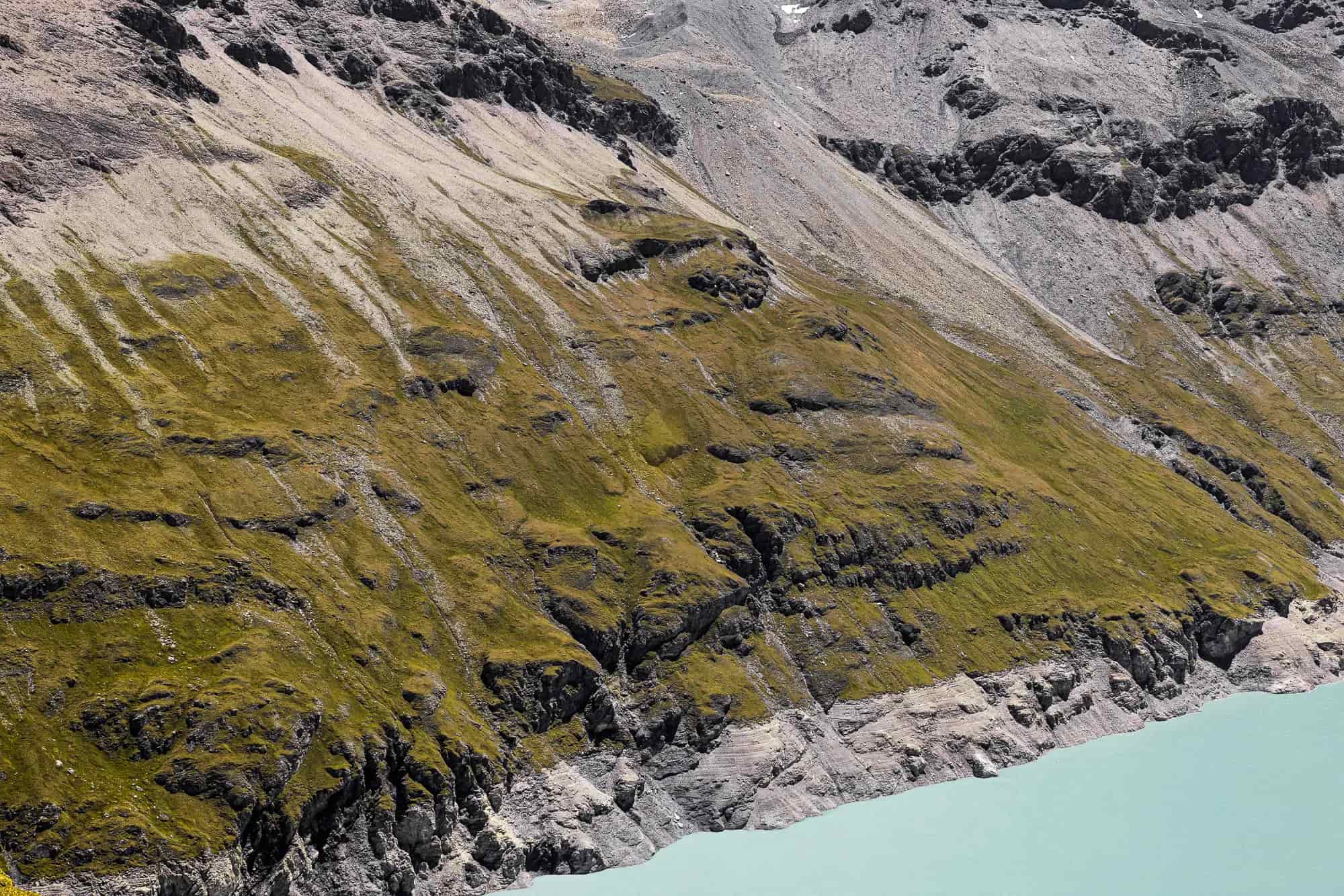
Increasing alpine dangers
Just as we write this article, another potential danger of melting glaciers and thawing permafrost in the Alps is tragically revealed. The demolition of a huge piece of glacier on the Marmolata in South Tyrol killed 11 people and injured many more, some seriously. In record temperatures, many tons of ice and rock plunged into the depths, overrunning a popular and highly frequented approach to the highest mountain in the Dolomites and once again highlighting how fragile the glacier system has now become.
Ice breaks have always existed, they are normal and are simply part of the life of a glacier. However, it is also undisputed that the warmer temperatures with the accompanying rising zero degree limit have an effect on the already unstable stability of ice and also rock with regard to permafrost.
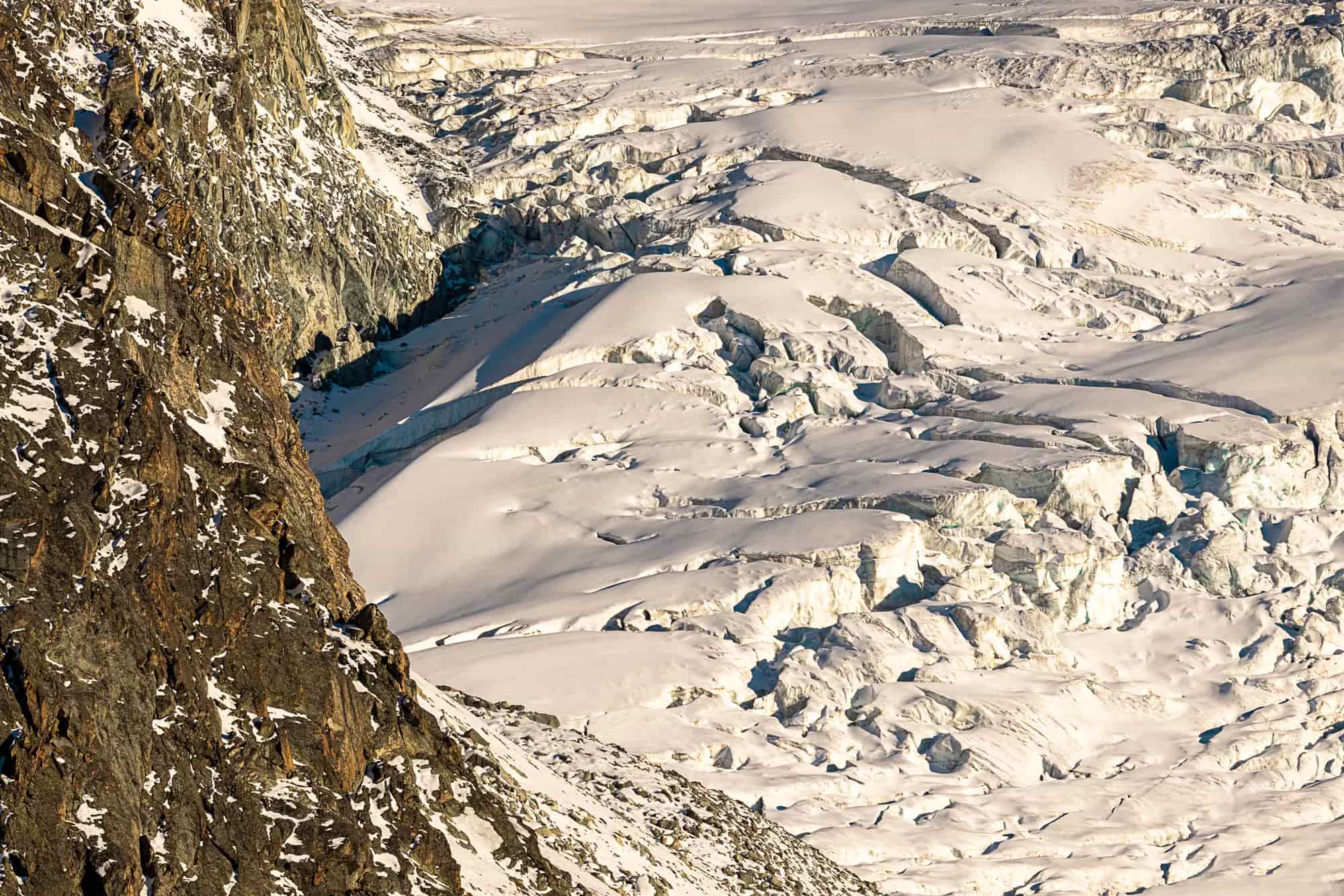
In addition to serac demolitions, thawing permafrost also plays a significant role here. Many alpine routes lead through terrain that is ultimately only kept in a stable condition by the permafrost. If this natural kit wears off, the risk of unpredictable hazards such as rockfall and even landslides increases. The notorious “Couloir of Death” on the approach to the 4807-meter-high Mont Blanc is a well-known and feared example of the dangers posed by rockfall. With diurnal warming, such places have always been highly dangerous. Now, if temperatures rise in general, one can already speak of Russian roulette when walking such routes – especially if, as in the case of the Grand Couloir du Goûter, it is the normal route up the highest mountain in the Alps, which is correspondingly frequented with over 20,000 climbers per year.
What remains is the glacial polishing that occurs wherever the glacial ice has retreated. The smoothly polished rocks, often covered with a thin, sandy layer, are a nightmare on any alpine route. This terrain is usually impossible to belay, but at the same time it is extremely tricky and, because of the early start times for high altitude tours, tends to be passed in the dark at lower elevations of the mountain. Here, too, the retreat of the glaciers ensures increasing dangers and an increased potential for accidents.
Also at Mont Collon in the Valais Alps, shown in the following picture, a major breakup of the impressive glacier on the summit plateau is expected in the near future. Regular measurements and observations should prevent worse, but here too, especially in winter, a well-known ski touring route passes in the immediate vicinity. It remains to be hoped that such a break-off is more likely to happen in the summer months, when the area below the northern flank is lonely and less frequented.

Can the glaciers still be saved?
Unfortunately, the answer from research institutes and scientists to this question is quite clear: no. The tipping point for glaciers has already been passed in many regions of the world.
All technical attempts, for example with fleece covers, are effective on a small scale, but for a large-scale application on the one hand nonsensical and above all too expensive. The only real help would be an immediate massive reduction of greenhouse gases. This is an increasingly unrealistic scenario, because as of 2022, the world is heading for global warming of 3-4° Celsius, and in some regions even more. In these scenarios, which are not to be regarded as “eventual scenarios” but as very realistic, Switzerland will be practically ice-free in 100 years at the latest. Even with a theoretical complete and immediate stop of further CO2 emissions, the glaciers would lose more than 30% of their mass.
People will therefore have to deal with increasingly urgent questions about electricity supply, how to deal with natural disasters caused by glacier recession, but above all questions about drinking water will probably cause us some headaches.
In about 2021, an experimental project by Swiss glaciologist Felix Keller made headlines, involving artificial snowmaking on the Vadret da Morteratsch, powered purely by pressure from meltwater, to slow the melting of the glacier through the protective layer of snow. At first glance, this was an almost hopeless, expensive project, which drew some criticism. At second glance, however, one will have to ask oneself in the future whether the supposedly healthy nature or the drinking water supply is to be considered more important – and which alternative options exist at all.
Glaciers in climate change are unmistakable indicators of global warming
Global glacier retreat – and with well over a billion people directly and indirectly dependent on glacier water, that’s fair to say – affects us all. We can consider glaciers as one of the best and easiest visible indicators of man-made global warming. Access to these monumental edifices of nature is easy for many people, the correlation “warm means ice melts, warmer means ice melts faster” is tangible and understandable to everyone.
It is to be hoped that we will no longer perceive glaciers merely as brief sightseeing attractions, but will draw our conclusions from our observations and incorporate them into our own actions in the interests of sustainability. This can start with vacation planning, on the daily commute to work, or when shopping for groceries. For we will probably no longer receive a clearer warning without expecting an incomparably more immediate impact on each and every one of us.
